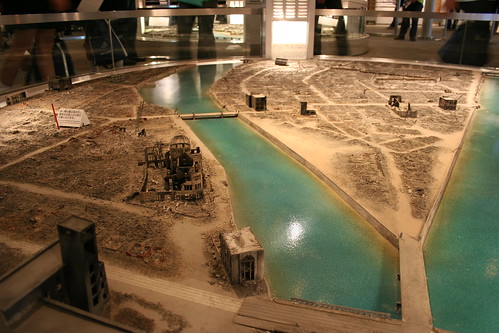I made my way to Hakata Station and bought my breakfast -- a small takeout box of sushi. I went to buy tickets for the Shinkansen bullet train, and boy, was it expensive. I had to buy two separate tickets for it. The first one is for the journey from Hakata Station to Hiroshima Station, and the other is some sort of zone/city boundary fee because I was going from one zone to another. The latter cost effectively doubled my fare cost, and was over double what the KTX cost me from Seoul to Busan (which is the most expensive a KTX ticket could go).
I thought the KTX bullet train in Korea was fast, but I was absolutely blown away by the Shinkansen. The Shinkansen went at around 400 km/h, while the KTX went around 300 km/h. The KTX waited to exit the city before it picked up speed, while the Shinkansen is already was full acceleration before it even left Fukuoka.

Above: The train was already in motion when this was taken. I was seated and reached high to take this photo. Good thing, because I didn't know it would go at 400 km/h before even reaching the farms!
Before long, I reached Hiroshima Station. It was about the same distance as Seoul to Daegu but only took about an hour. The difference between the two commutes was really remarkable.
As you may have guessed, one of the main reasons for me wanting to go to Hiroshima is because I wanted to see the atomic bomb memorial. While Tokyo is easy to reach from most places, Hiroshima is in southern Japan and is harder to get to from anywhere else -- except Korea. With the long weekend, it seemed like the perfect time to make this trip.
I may sound insensitive for saying this, but one of the unintended consequences of the atomic bomb attack was that it made Hiroshima a big tourist attraction. The Japanese seem to have a reputation for knowing how to deal with tourists, and this was no exception. The directions to certain attractions are very clear and easy to understand, and a lot of signs are even quadlingual (in 4 languages).
The distance from Hiroshima Station to the atomic bomb memorial wasn't too bad. The first place I encountered there was probably the most famous sight of all -- the Genbaku Dome, also known as the Atomic Bomb Dome.
Above: The ruins of the Atomic Bomb Dome.
The Atomic Bomb Dome was a lot more ruined and destroyed than I expected. But then again, as I said, I don't know what the hell I was expecting. Of course it's going to look ruined and destroyed -- it was hit by an ATOMIC BOMB. There was rubble lying around everywhere, as they seem to have left most of the debris untouched.
After the Atomic Bomb Dome, I went to the nearby memorial park where they had many monuments and statues, including one dedicated to the children victims of the attack, inspired largely by Sadako Sasaki, the Japanese girl who folded over a thousand paper cranes in an act of hope.
Above: Paper cranes on display.
Adjacent to the park is a museum detailing the historic events leading up to and after the atomic bomb attack. Admission was cheap (about 50 cents Canadian) and well worth it.
Above: A model of Hiroshima before and after the atomic bomb attack.
Some of the displays were a bit graphic and jarring. One of the most memorable displays had the front steps of a bank with a large shadow on it. Someone was sitting on the steps of the bank, waiting for it to open, when the atomic bomb was dropped. The person was incinerated to death on the spot but his sitting body shielded part of the steps from the radiation, resulting in a shadow. That was a bit creepy.
From what I keep hearing about Japan, I didn't expect to see anything in the museum admitting imperial Japan's role in the war. But I was a bit surprised because they dedicated a large section of the museum showing the errors and atrocities that the imperial Japanese government committed prior to the end of the war. I wasn't expecting this at all.
After the museum, I went for more pleasant surroundings at the Hiroshima Castle. I didn't go inside many of the buildings but it was nice to see something not related to the atomic bomb.
Above: Exterior view of the ninomaru of Hiroshima Castle.
After Hiroshima Castle, I decided to make my way back to Fukuoka. Back in Fukuoka, I did mostly exploring, as it was getting late and a lot of places were closing. I had to hurry in order to get things in before daylight was completely lost.
Above: The ruins of Fukuoka Castle.
After exploring, I went for dinner. Being in Japan, I felt like I should probably get sushi -- so I can go home and say I had sushi in Japan.
Sushi is considered a luxury in Japan, so the bill was a lot more expensive than a normal meal. But this is something any visitor to Japan must do, so the cost was secondary to the experience.
After this, it was getting rather late. I went back to the hostel. I met some of the other hostel guests. We had a nice chat about places we visited, as well as share stories about living abroad. (Those of us who have been to Korea shared an inside joke about the horrible drivers here.) After it was done, I took a shower and went to bed.
---
Coming next:
- Insane weekend: To Fukuoka (photos): Day 3































































